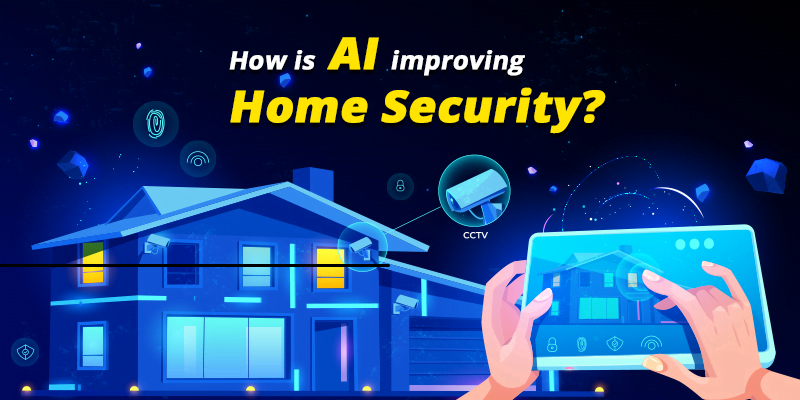The growth of artificial intelligence (AI) in recent years has revolutionized several sectors, including home security. Homeowners now have access to a new generation of intelligent security systems that can actively monitor, analyze, and respond to possible threats thanks to the integration of AI technology. The Artificial Intelligence Course provides a comprehensive understanding of AI technologies and their applications, including their role in enhancing home security.
In this post, we will look at how artificial intelligence is boosting home security, increasing the safety of residential environments, and giving homeowners peace of mind.
Intelligent Surveillance Systems
AI-powered surveillance systems are changing home security. Traditional security cameras required human operators to manually monitor footage, which was time-consuming and error-prone. AI algorithms have turned these systems into proactive defenders capable of detecting and analyzing possible threats in real-time.
Cameras can recognize objects, individuals, and even particular behaviors using advanced computer vision algorithms, allowing them to distinguish between normal and questionable activity. AI surveillance systems may continually learn and enhance their capacity to detect and respond to security breaches by employing deep learning algorithms.
AI algorithms are used by intelligent surveillance systems to recognize and track things in the camera’s field of view. These systems can recognize and discriminate between numerous things, such as automobiles, animals, or persons, by utilizing computer vision algorithms. This allows the system to zero in on prospective dangers and responds appropriately.
AI systems can also analyze and understand human behavior recorded by security cameras. The algorithms can recognize regular patterns of behavior and flag suspicious or unexpected activity by learning from large datasets. They can tell the difference between someone strolling along an approved path and someone attempting to enter a prohibited area.
Facial Recognition Technology
Facial recognition technology has become a common element in current home security systems. Using AI algorithms, cameras can properly identify anyone approaching the premises, adding an added layer of security. Homeowners may build customized access restrictions that permit admittance to authorized persons while warning them of unfamiliar or questionable faces. Furthermore, AI-powered face recognition systems may interact with other devices, such as smart locks or alarm systems, allowing for seamless automation and management.
Voice Recognition and Smart Sensors
AI-powered smart sensors help to improve home security by sensing and analyzing numerous environmental conditions. These sensors may detect possible hazards or intrusions by detecting changes in temperature, humidity, sound, and motion, among other things. These devices can use machine learning algorithms to distinguish between typical and abnormal behaviors, prompting alarms or starting appropriate actions.
Another AI-driven breakthrough is speech recognition technology, which allows homeowners to operate their security systems using spoken commands. This hands-free interaction enables easy operation and connection with other smart home devices. Homeowners can simply equip and disable their security systems, receive real-time information, and even call emergency assistance by using speech recognition.
Anomaly Detection and Predictive Analysis
AI systems can analyze massive volumes of data to detect patterns, trends, and anomalies. Predictive analytic capabilities in home security systems allow them to use past data to forecast possible security issues. These systems can forecast the possibility of future threats, such as break-ins or suspicious activity, by reviewing historical instances, allowing homeowners to adopt proactive risk-mitigation steps.
- Data Collection: The home security system gathers and saves pertinent data from a variety of sources, including surveillance cameras, motion sensors, and access control records.
- Data Analysis: AI algorithms examine the acquired data for patterns, correlations, and anomalies. They find common features or circumstances linked to prior security issues.
- Pattern Recognition: The system learns to recognize patterns and trends that suggest a possible security issue based on the study. For example, it may recognize particular behaviors that precede an attempted break-in or pinpoint a specific time of day when most burglaries occur.
Anomaly detection methods boost security by detecting unexpected patterns or behaviors. To develop baseline behaviors, these algorithms continually analyze data from numerous sensors and gadgets around the home. When these patterns are disrupted, for as by unexpected movement or unusual access attempts, the system might send alarms or activate countermeasures.
- Baseline Behaviour Establishment: Over time, the AI algorithms collect data to construct a baseline of normal behavior in the household. This covers elements such as movement patterns, entry and exit timings, and device usage.
- Deviation Identification: After establishing the baseline behavior, the system continuously monitors the environment for any deviations or anomalies. It analyses real-time data to predefined patterns and detects any major discrepancies.
- Determination of Thresholds: Anomaly detection systems set thresholds or criteria that decide what amount of deviation is considered significant. This reduces false positives caused by slight changes or noise in the data.
Smart Home Technology Integration
AI-powered home security systems work in tandem with other smart home devices to provide a full ecosystem. This connection enables homeowners to remotely operate and monitor their security systems via smartphones or other connected devices. Homeowners may keep ongoing monitoring over their property regardless of their physical location by receiving real-time notifications, seeing live video feeds, or remotely controlling locks and alarms.
Furthermore, AI-powered security systems may work with other smart home equipment, such as lighting systems or smart speakers, to mimic occupancy while homeowners are not there. This gives the impression that the house is occupied, repelling possible invaders.
Conclusion
AI has heralded a new age in home security, changing old defense tactics into intelligent and proactive solutions. The incorporation of AI algorithms with surveillance cameras, face recognition technology, smart sensors, and voice recognition has greatly improved the efficacy and ease of home security systems. Homeowners may enjoy better safety and peace of mind with predictive analysis, anomaly detection, and seamless interaction with other smart home devices.
However, it is critical to address possible privacy risks and ethical concerns related to AI-powered home security. As technology advances, industry stakeholders should prioritize openness, user permission, and effective security measures to guarantee that AI-enhanced home security systems strike the appropriate balance between safety and privacy.
Finally, the rise of AI in home security demonstrates the technology’s transformational potential. Homeowners may secure their assets and loved ones more effectively by using the potential of AI, promoting a sense of security in an increasingly connected world.













Comments